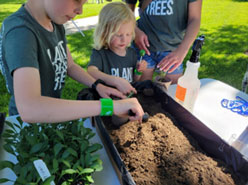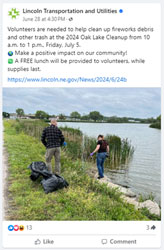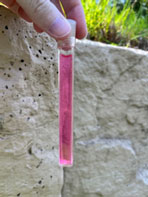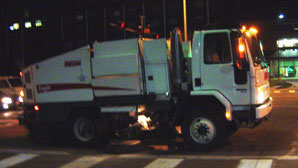NPDES Annual Report
National Pollutant Discharge Elimination System
MS4 Permit No. NE0133671
Annual Report Summary September 1, 2023 – August 31, 2024
Administratively Extended Year 6
City of Lincoln, Nebraska
 Did you know dog waste is full of bacteria that can pollute local waterways if it’s left behind? Protect your walk and your water from dog waste and bring a bag with you.
Did you know dog waste is full of bacteria that can pollute local waterways if it’s left behind? Protect your walk and your water from dog waste and bring a bag with you.
Submitted By: Lincoln Transportation and Utilities | Watershed Management Division
Prepared By: Shannon Ideus, Senior Environmental Health Specialist
Reporting Requirements Summary
The City of Lincoln is required by federal law to comply with the provisions of the Federal Clean Water Act. In Nebraska, the U.S. Environmental Protection Agency has given the Nebraska Department of Environment and Energy (NDEE) the authority to implement the conditions of the Clean Water Act and the responsibility to ensure municipalities in Nebraska are compliant.
The City of Lincoln complies with these mandated regulations through a State-issued National Pollutant Discharge Elimination System (NPDES permit (PDF, 2MB)). On October 2, 2018, the City was re-issued an NPDES permit by the State of Nebraska, allowing municipal stormwater discharges to local waterways and lakes effective November 1, 2018 – October 31, 2023.
(PDF, 2MB)). On October 2, 2018, the City was re-issued an NPDES permit by the State of Nebraska, allowing municipal stormwater discharges to local waterways and lakes effective November 1, 2018 – October 31, 2023.
This is a summary of the City’s efforts reported to the NDEE for the period beginning 9/1/23 to 8/31/24. The reporting period is reflective of the permit, signed on October 2nd, 2018, by the Water Permits Division Administrator. The current permit expired October 31, 2023. The City’s NPDES Permit has been administratively extended effective November 1, 2023, until a new permit is issued by the State.
Note: The City’s fiscal year, which ended August 31, 2024, is slightly different than the NPDES permit year 2024, which ends December 31, 2024.
The following is a list of programs the city has implemented to comply with the State’s requirements for Lincoln’s municipal stormwater NPDES permit.
Each program (numbered 1-8) contains a link to an EPA website to provide a summarized description of the requirements.
The items listed below are non-inclusive of all efforts made by the city in the 2023-24 fiscal year.
In this permit year, Watershed Management partnered with numerous agencies to promote water quality.
The “I Love My Dog Expo” sponsored by Parkview Animal Hospital was held March 23, 2024, and was attended by Animal Control. Watershed provided pet waste dispensers marked “Stop Poo-llution” to encourage citizens to pick up after their dogs.
 “I Love My Dog Expo Small Animal Encounter Activity”
“I Love My Dog Expo Small Animal Encounter Activity”
 Vactor Truck Large Equipment Encounter
Vactor Truck Large Equipment Encounter
Watershed Management, Solid Waste, Traffic, Water, Wastewater, Street Maintenance, Parks and the Lincoln Fire Department teamed up at a free Large Equipment Encounter event held September 6 and 7, 2023. Items on display included: Mini excavator/jet flusher, tv inspection equipment, recycler machine, backhoe/utility trucks, drones, watershed model/sampler, traffic truck, signals, flasher poles, snow truck/wheel loaders and fire trucks.
 Watershed Model at Large Equipment Encounter
Watershed Model at Large Equipment Encounter
Watershed Staff attended the Arbor Day LNK event held May 11, 2024.
Watershed hosted an outreach booth focused on promoting the use of native “waterwise” plants in home gardens. These plants feature deep root systems that enhance soil health, improve water infiltration, and increase resilience during hot, dry conditions—ultimately supporting water conservation efforts.
 Free Seedlings provided at the Arbor Day LNK Event in Lincoln May 11, 2024
Free Seedlings provided at the Arbor Day LNK Event in Lincoln May 11, 2024
The event was well attended, with staff engaging in over 80 meaningful interactions with community members.
 Attendees potting their seedlings at the Arbor Day Event
Attendees potting their seedlings at the Arbor Day Event
Social media continues to be an important tool for promoting upcoming educational events and encouraging responsible practices that support local water quality.
Examples include encouraging residents to properly dispose of fireworks debris, recruiting volunteers for stream cleanup events, notifying the public of free educational opportunities, and reminding pet owners to clean up after their dogs — all efforts aimed at protecting and improving local water quality.
 Social Media Post Regarding the importance of picking up pet waste
Social Media Post Regarding the importance of picking up pet waste
 Social Media Post Regarding picking up fireworks debris
Social Media Post Regarding picking up fireworks debris
 Social Media Post Regarding volunteers needed for a stream cleanup
Social Media Post Regarding volunteers needed for a stream cleanup
Watershed Management hosts open houses to engage the public and provide information on upcoming projects.
One such event, focused on the Flood Mitigation Master Plan, was held on Tuesday, September 26, 2023, at the Belmont Recreation Center.
 Flood Mitigation Master Plan Open House at Belmont Rec Center
Flood Mitigation Master Plan Open House at Belmont Rec Center
 Trash Collected at Oak Lake Clean Up Event July 5, 2024
Trash Collected at Oak Lake Clean Up Event July 5, 2024
The Watershed Management Division actively engages local residents in protecting our waterways through the Adopt-a-Stream program. As new stream segments are added to the program, volunteer participation continues to grow. During this reporting period, 282 volunteers participated in 23 cleanup events, collectively removing 9,253 pounds of trash from local streams, creeks, and waterways.
 Total trash/debris removed was weighed and properly disposed of
Total trash/debris removed was weighed and properly disposed of
Nebraska Game and Parks also contributed to the program by organizing a “Kayak Cleanup” event at Holmes Lake in September 2024. Volunteers collected 78 pounds of trash and debris from the lake during this event.
 Game and Parks held a Kayak Cleanup at Holmes Lake
Game and Parks held a Kayak Cleanup at Holmes Lake
Removing trash from streams and their surrounding areas not only fulfills public engagement requirements under the permit but also contributes directly to improving local water quality.
Used oil collected from the public at the North 48th Street Solid Wastement Management Facility totaled 900 gallons (total for KNB green” for the FY 23-24). Other oil recycling is specific to the equipment/vehicle maintenance operations for the Solid Waste Management Division with a total collection of 1465 gallons.
 Properly Dispose of Used Oil Only at Approved Locations
Properly Dispose of Used Oil Only at Approved Locations
Diverting the used oil to recycling centers helps prevent storage/spillage at the municipal sites as well as households that could impact overall water quality.
In the Summer-Fall seasons of 2023-24 the dry weather team monitored 50 outfall sites in Lincoln (including one revisit from 2023). A total of 15 samples were collected at sites that were found to have flow to detect potential illicit and illegal connections to the storm drain system. Monitoring locations are shown in Figure 1(PDF, 742KB).
 Testing Done on Flow Found During Dry Weather Monitoring
Testing Done on Flow Found During Dry Weather Monitoring
Lincoln Lancaster County Health Department (LLCHD) investigated 67 reports of illicit discharges, with 17 of those having actual water impact.
 Accident spills are significant sources of illicit disharges to the storm drain system
Accident spills are significant sources of illicit disharges to the storm drain system
The Health Department conducts investigations and enforcement for HazMat responses as appropriate.
Examples of illicit discharges include vehicles leaking fuel, oil, or other fluids; paint washed out of brushes or rollers at the curb; grease discharges from restaurants; grey water or wastewater discharges; antifreeze and other chemicals spilled, dumped, poured or power washed into the storm drain system; and garbage junk and litter.
 Illicit Discharge Example by EPA of an oil sheen on the water
Illicit Discharge Example by EPA of an oil sheen on the water
LLCHD and Lincoln Fire and Rescue’s actions minimize the contamination of water. Responsible parties are required to clean up the illicit discharge. If no responsible party is identified, LLCHD’s response contractor conducts the cleanup.
Some responses involve multiple departmental/divisional response:
The dredging of the 139-year-old Wyuka Cemetery Pond was a joint community effort to create not only an aesthetically pleasing place to visit, but act as a stormwater runoff zone that drains over 255 acres of land south of “O” Street.
 Wyuka Cemetary Pond Negotiations began 2017
Wyuka Cemetary Pond Negotiations began 2017
 The newly dredged pond looking at the Swan House
The newly dredged pond looking at the Swan House
The cemetery will be the new home of the Pershing Auditorium Mural and a future all-inclusive playground.
While community improvement projects are essential, they can occasionally result in unforeseen challenges. During the pond dredging project, several mud spills occurred on November 7, 2023, affecting multiple locations, including:
- 27th Street & Vine Street
- Antelope Valley Roadway & Salt Creek Roadway
- North 14th Street & Cornhusker Highway (westbound)
The contractor responded promptly to contain and address the spills. Lincoln Transportation and Utilities Street Maintenance crews also responded quickly, and the Lincoln-Lancaster County Health Department was notified and assisted with the cleanup efforts.
Several locations of illicit discharges for FY 2023–24 are illustrated in Figure 2(PDF, 885KB).
The Watershed Management Division maintains a centralized database for tracking construction site permits and related inspection activity. construction site activity. All inspections conducted by Watershed Management staff are logged into this database and spatially mapped for analysis (see Figure 3(PDF, 910KB)).
During the permit period from September 1, 2023, through August 31, 2024, a total of 4,114 inspections were performed on small construction sites (less than one acre), and 903 inspections were conducted on large sites (one acre or greater).
To encourage public engagement and raise awareness, the city offers an online reporting platform, SeeClickFix. One of the designated reporting categories is “Mud in the Street Due to Construction.” (See Figure 12(, 0B) for reported locations.)
 Training is provided to site contractors and developers
Training is provided to site contractors and developers
In addition to on-site education, the city provides annual training to Contractors to ensure compliance with permit requirements and to communicate any regulatory updates. This year’s Sediment and Erosion Control Seminar was held on January 25, 2024, at the Museum of American Speed. Details about the annual training can be found at lincoln.ne.gov using the keyword “sediment.”
Staff also participated in the 811 Summit on February 21, 2024, which focuses on One Call safety.
This event brings together contractors from various industries and offers a valuable opportunity for sediment and erosion control inspectors to promote best practices on construction sites.
 Staff attended the 811 Summit Conference
Staff attended the 811 Summit Conference
Watershed Management staff conducted 85 inspections of retention and detention ponds to evaluate their effectiveness in reducing stormwater pollutants and providing flood control (see Figure 8(PDF, 744KB) for locations). The inspection findings are available in the Retention/Detention Pond Summary Report.
In addition, 67 Post-Construction Best Management Practice (BMP) sites were inspected, and staff reviewed 22 new Post-Construction BMP applications during the reporting period.
 Northwest High School East End PCBMP
Northwest High School East End PCBMP
Some retention and detention basins are transferred to Homeowners Associations (HOAs) for ongoing maintenance. Typical maintenance responsibilities include:
- Managing vegetation and weeds (manual removal or mowing)
- Removing trash and floating debris
- Inspecting inlet and outlet structures for blockages or damage
- Monitoring sediment accumulation within the basin
- Replanting or reseeding vegetation as needed
- Checking for signs of mosquito breeding
- Identifying and addressing erosion issues
- Performing other general upkeep as necessary
Residents and property owners are encouraged to review the specific maintenance requirements associated with the water quality feature in their area.
All curbed streets are swept annually, at a minimum. Additional sweeping occurs on arterial and residential streets in high debris zones to reduce litter and pollutants from entering the storm drain system. Sweeping activities shall follow LTU’s street sweeping operating procedure.
A total of 9,890 lane miles of residential streets, 9,440 curb miles of arterial streets, and 769 curb miles in business districts were swept during this permit term. Combined, these efforts resulted in the removal of approximately 3,868 tons of debris, which would have otherwise entered local streams, creeks, and retention ponds.
 Street sweepers, such as the one shown above, can be used to clean roadways on a regular schedule.
Street sweepers, such as the one shown above, can be used to clean roadways on a regular schedule.
The Downtown Lincoln Association (DLA) also conducted sidewalk sweeping in the downtown business district, focusing on areas prone to high trash accumulation. Annually, approximately 1,425 cubic yards of debris are collected through this effort (see Figure 13(, 0B) for the DLA sweeping map).
City crews continued inspections of manholes, inlets, and piped storm drainage systems to ensure proper function and to verify that no illicit sanitary connections exist within the storm drain network.
 Street Sweeper Totaled in a Fire April 15, 2024
Street Sweeper Totaled in a Fire April 15, 2024
On April 15, 2024, a fire destroyed one of the City’s Street sweepers, resulting in a total loss. This incident temporarily reduced sweeping capacity by 25%. Despite this setback, the city-maintained compliance with stormwater management permit requirements for debris removal.
Additionally, 8,554 linear feet of storm drainpipe were replaced or improved as part of key infrastructure projects, including:
- Yankee Hill Road, from 40th Street to Rokeby Road
- Rokeby Road, from 40th Street to Snapdragon Road
 Project Page for 40th Street from Yankee Hill Road to Rokeby Road
Project Page for 40th Street from Yankee Hill Road to Rokeby Road
Further details about these and other Watershed Management projects are available on the City of Lincoln Watershed Management website, using the keyword “projects.”
In this permit term, the Health Department conducted inspections at 23 municipal facilities that are required to be inspected under EPA’s “Good Housekeeping” program. (see Figure 6(PDF, 737KB)).
 Municipal Inspections are conducted annually by the Health Department
Municipal Inspections are conducted annually by the Health Department
Ninety-eight industrial facilities were inspected for compliance with State of Nebraska issued NPDES permits. One of the Mayor's Performance Indicators for Water Quality is to assure that at least 90% of industries pose minimal risk of illicit discharge to the stormwater system. In FY 23-24, 96% of the facilities posed minimal risk of illicit discharge. For the past nine years, this performance indicator has been achieved. (see Figure 7(PDF, 753KB)).
The State approved the use of Best Management Practices (BMP) monitoring to fulfill wet weather monitoring requirements for this permit term. This year served as an administrative extension of the current permit, providing staff additional time to review existing monitoring sites and evaluate the need for new ones.
 Pave Drain area at 12th & “D” with Sample Bottles at the Outflow
Pave Drain area at 12th & “D” with Sample Bottles at the Outflow
Data collected from this year’s monitoring efforts is summarized in the Stormwater BMP Monitoring Interim Report. A comprehensive analysis will be included in the final report, which will be submitted in year five of the new permit cycle, as determined by the State Department of Environment and Energy.
Current BMP monitoring sites include:
- Planters at the Municipal Service Center
- Tyrrell Park Regional Bioretention Area
- Storm Drain Inlet Filter at Coffee Shop (New)
- Pave Drain Alley – Permeable Pavers (New)
- Cedar Cove Hydrodynamic Separator (New)
Based on the final data analysis, some monitoring sites may be adjusted or replaced in the next permit term.
 Automatic Sampler set up at Cedar Cove
Automatic Sampler set up at Cedar Cove
Figures
PDF format 
- Figure 1 - Dry Weather Monitoring Locations(PDF, 742KB)
- Figure 2 - Illicit Discharge Complaints/Response Locations(PDF, 885KB)
- Figure 3 - Erosion and Sediment Control Complaints/Response Locations(PDF, 910KB)
- Figure 4 - Grading Inspection Locations(PDF, 875KB)
- Figure 5 - Basin Inspection Locations(PDF, 744KB)
- Figure 6 - Municipal Facility Inspection Locations(PDF, 737KB)
- Figure 7 - Industrial Facility Inspection Locations(PDF, 753KB)
- Figure 8 - Post Construction BMP Inspection Locations(PDF, 744KB)
- Figure 9 - Cost Share Projects(PDF, 761KB)
- Figure 10 - Cost Share Rain Gardens 2007 - 2020(PDF, 749KB)
- Figure 11 - Illicit Discharge Complaints/Response Locations on State of NE / UNL Property(PDF, 773KB)
- Figure 12 - Mud in the Street Locations(, 0B)
- Figure 13 - Downtown Haymarket Sweeping Map(, 0B)